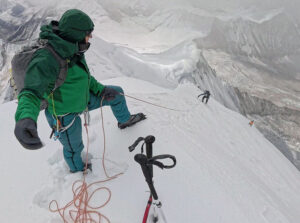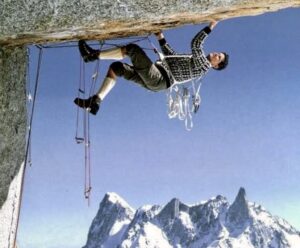The first time we heard of Flor Cuenca was in late July, from an outfitter in Pakistan.
“Keep an eye on her climbing,” he said. “She is stronger than most men in Base Camp and has been leading the way, carrying everything and breaking trail on the upper sections of Gasherbrum I.”
Sixty-six days later, Cuenca watched the sunrise from the summit of Dhaulagiri. It was her fifth 8,000’er. As always, she climbed without supplementary O2.
Cuenca, 44, defines herself as a Himalayan Cinderella. Born in Peru, she has few sponsors. Instead, she works hard in Germany to earn enough money to climb, usually on a shoestring budget.
ExplorersWeb talked to her after her arrival in Kathmandu. She arrived there days later than other October 1 summiters, because she couldn’t afford the helicopter ride. Instead, she trekked back to Pokhara.
This time, on Dhaulagiri, a friend with whom she had planned to share a tent and equipment carries up the mountain had acclimatization problems. So Cuenca went up to Camp 3 in one go, joining the lead Sherpa rope fixers and Sirbaz Khan, with whom she joined forces on the summit push. Living together with these hard mountain men has been the most rewarding part of the climb, and a major eye-opener.

Flor Cuenca, centre rear, and the Sherpa rope fixers. Photo: Lakpa Dendi
“Their packs felt full of lead”
“Being together with the rope-fixing team really made me realize how incredibly hard their work is,” she said. “It’s difficult to describe what these guys do, what they endure: They carry everything, from their tents, gear and food, to O2, climbing and fixing gear, ropes….and I’m not talking about a couple of rolls. On the summit push, they carried 1,000m of ropes! Once I tried to put on one of their backpacks. Man, I can carry 30kg all right, but theirs were like full of lead!”
Cuenca added that when the Sherpas finally reached camp and put up their tents, they were so exhausted that they had no strength left to cook. “I was so impressed!” she said.

On the way to Camp 1, under Dhaulagiri’s “Eiger”. Photo: Flor Cuenca
Cuenca’s first impression of the Dhaulagiri climb is that “it was so fast”. She arrived in Nepal on August 30, because she was unsure about quarantine requirements and so gave herself plenty of time.
“After five days, they let me go, so I set off on the Annapurna trek, which helped me to acclimatize,” she explained. “I also had some acclimatization left from Gasherbrum I.”
So when Cuenca arrived at Dhaulagiri Base camp on September 17, she felt good to go up after just a couple of days’ rest.
Teamed up on Dhaulagiri with Sirbaz Khan
“I went all the way to Camp 3 (7,100m), where I spent the first night,” she said. “Up there, there was only another person: Sirbaz Khan of Pakistan. We quickly decided to join forces and share the weight of tent and gear. On the following day, we climbed up to 7,250m and returned to BC.”

Relaxing in the sun at Camp 3. Photo: Flor Cuenca
“After a couple of days of bad weather in BC, it was time for a summit push,” Cuenca said. “The rope-fixing team set off, and Sirbaz Khan and I followed. The problem was that after the heavy snowfall, the trail was buried and it had to be opened again. I helped as much as I could, taking shifts to break trail.”
Cuenca’s account of the summit push:
“On the first day, we couldn’t reach C3 and stopped instead at 6,700m. The next day, we were caught in a snowstorm, which loaded the mountain even more, and we could barely reach C3.
“From Camp 3, a first Sherpa team went up to fix as far as possible. They returned with rather pessimistic news of waist-deep snow. They rested for some hours and at 10 pm, as soon as it stopped snowing, they set off again. This time, they hoped to reach the summit. It was September 29.

Flor Cuenca during a cold summit night. Photo: Flor Cuenca
“After the fixers, a number of clients followed, including the Indians, Pasang Lamu, etc. All on O2. We were the only no-O2 climbers who had spent a night at C3.
“Sirbaz and I planned to set off some three hours later, in order to avoid being stopped by the rope-fixing work. We wouldn’t carry supplementary O2. But just as we got out of the tent, the entire team returned. At first, we worried about an accident, but they said that the upper part of the mountain was too dangerous because of all the snow. They told us that the push, and the expedition, was over.

Sirbaz Khan refused to leave Camp 3 when the word came that the expedition was over. Photo: Flor Cuenca
The rope fixers were exhausted
“People continued descending, but Sirbaz and I decided to stay one more night in Camp 3 and maybe check what was it like the following day. There was much discussion between camps over the radio. The rope-fixing team was exhausted.
“Eventually, Sanu Sherpa (he’s so good!), on his double 14×8,000’er challenge, said he wanted to try, and some other Sherpas followed. They set off again from Camp 3 at 11 am on September 30 and worked hard until they reached the summit at 5:30 am on October 1.

Climbers traverse below Dhaulagiri’s summit before sunrise. Photo: Sophie Lavaud
“The second group that set off towards the top was larger. As for us, we stuck to the same strategy. We waited for three hours in the tent. Going without O2, we wanted to give the fixing team time to do their work and to avoid to getting stuck on the upper slopes.

Atop Dhaulagiri. Photo: Flor Cuenca
“We set off at around 7 pm and climbed in the night. We went up the ridge and completed the traverse under the summit ridge until a couloir. Here, the rope-fixing team and some clients were waiting in line. It was around 4 am. I was so cold and so tired, I only wanted to sleep and wait for the sun to come up.
“In fact, I sort of dug a hole and curled myself in the snow. I could listen to the sounds of the ice from inside the hood…I dozed at some point…then something woke me up: The line was moving and the way to the top was open.

Flor Cuenca and Sirbaz Khan on the summit. Photo: Flor Cuenca
“I reached the top at 6 am. Conditions on the upper sections were marginal. There was a lot of snow, but well, we took the risk and it worked. Luckily, there were no accidents.
“After the summit, we went down as quickly as we could. With the sun out, the avalanche risk increased and we wanted to finish with the traverse under the summit area as soon as possible.

The route on Dhaulagiri. Photo: Sophie Lavaud (who also summited on October 1)
“After reaching Camp 3, I wanted to rest there for the night, but Sirbaz insisted we should go lower down. So we retrieved everything, including the tent and our garbage, and proceeded to Camp 2. We reached Base Camp on the following day, October 2.”

Celebrating the summit back in Base Camp with Pasang Lamu Sherpa. Photo: Flor Cuenca
Flor Cuenca has no immediate plans for more climbing. “Now I have to return to Germany and work,” she said. “If I manage to save enough money, I’ll try to go to Pakistan next summer. But it’s still too soon to tell.”
Later Dhaulagiri summits:
Flor Cuenca confirmed that at least Csaba Varga and a Chinese woman summited without O2. Several people saw the climbers from India using O2 on the way down.
After that first push, more summits came on October 7, including Nirmal Purja’s two clients, Adrianna Brownlee of the UK, Asma Al Thani of Qatar, and four Sherpa guides. Among them was Dawa Yangzum, fresh from the main summit of Manaslu. Purja’s Elite Exped team reached the foresummit on Manaslu.






